

Salmonella. Salmonella /ˌsælməˈnɛlə/ is a genus of rod-shaped, Gram-negative bacteria.

There are only two species of Salmonella, Salmonella bongori and Salmonella enterica, of which there are around six subspecies and innumerable serovars. The genus belongs to the same family as Escherichia, which includes the species E.coli. Salmonellae are found worldwide in both cold-blooded and warm-blooded animals, and in the environment. They cause illnesses such as typhoid fever, paratyphoid fever, and food poisoning.[1] Features[edit] General Information on Salmonella. Salmonellosis is an infection with bacteria called Salmonella.
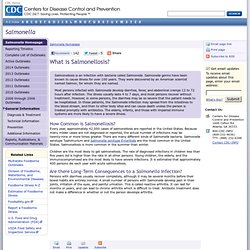
Salmonella germs have been known to cause illness for over 100 years. They were discovered by an American scientist named Salmon, for whom they are named. Most persons infected with Salmonella develop diarrhea, fever, and abdominal cramps 12 to 72 hours after infection. The illness usually lasts 4 to 7 days, and most persons recover without treatment. However, in some persons, the diarrhea may be so severe that the patient needs to be hospitalized.
How Common is Salmonellosis? Salmonella Bareilly and Nchanga Infections Associated with a Raw Scraped Ground Tuna Product - Salmonella. Introduction CDC collaborated with public health officials in many states and the U.S.

Food and Drug Administration (FDA) to investigate a multistate outbreak of Salmonella Bareilly and Salmonella Nchanga infections associated with an imported frozen raw yellowfin tuna product, known as Nakaochi Scrape, from Moon Marine USA Corporation. Salmonella Bareilly and Salmonella Nchanga are unusual serotypes of Salmonella in the United States. Public health investigators used DNA "fingerprints" of Salmonella bacteria obtained through diagnostic testing with pulsed-field gel electrophoresis, or PFGE, to identify cases of illness that may be part of this outbreak. They used data from PulseNet, the national subtyping network made up of state and local public health laboratories and federal food regulatory laboratories that performs molecular surveillance of foodborne infections. Among 425 persons for whom information was available, illness onset dates ranged from January 1 to July 7, 2012. Salmonella nomenclature. Salmonella and Salmonellosis.
To search the entire book, enter a term or phrase in the form below Custom Search Salmonella and Salmonellosis (page 1) (This chapter has 5 pages) © Kenneth Todar, PhD Salmonella is a Gram-negative facultative rod-shaped bacterium in the same proteobacterial family as Escherichia coli, the family Enterobacteriaceae, trivially known as "enteric" bacteria.
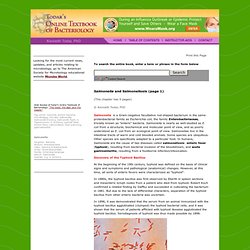
Discovery of the Typhoid Bacillus At the beginning of the 19th century, typhoid was defined on the basis of clinical signs and symptoms and pathological (anatomical) changes. In 1880s, the typhoid bacillus was first observed by Eberth in spleen sections and mesenteric lymph nodes from a patient who died from typhoid. In 1896, it was demonstrated that the serum from an animal immunized with the typhoid bacillus agglutinated (clumped) the typhoid bacterial cells, and it was shown that the serum of patients afflicted with typhoid likewise agglutinated the typhoid bacillus. The phs gene and hydrogen sulfide production by Salmonella typhimurium. CAFOS and Salmonella. Chicken Plant Spreading Salmonella, Agriculture Department Powerless to Sto. Photo Credit: © koko-tewan/ Shutterstock.com October 14, 2013 | Like this article?
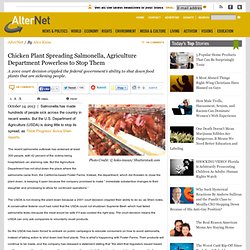
Join our email list: Stay up to date with the latest headlines via email. Salmonella has made hundreds of people sick across the country in recent weeks. The recent salmonella outbreak has sickened at least 300 people, with 42 percent of the victims being hospitalized--an alarming rate. The USDA is not closing the plant down because a 2001 court decision crippled their ability to do so, as Shen notes. So the USDA has been forced to embark on public campaigns to educate consumers on how to avoid salmonella, instead of taking action to shut down bad food plants. The salmonella outbreak is occurring in the midst of a government shutdown that has furloughed federal workers, including those who work for the Centers for Disease Control and Prevention. Feed one likely source of salmonella in eggs, federal officials say.
Are organic cage-free eggs safer?
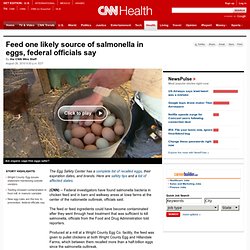
Wright County Egg issues statement mentioning outside vendorsTesting showed contamination in food mill, in manure samplesNew egg rules are the key to prevention, federal officials say The Egg Safety Center has a complete list of recalled eggs, their expiration dates, and brands. Here are safety tips and a list of affected states. (CNN) -- Federal investigators have found salmonella bacteria in chicken feed and in barn and walkway areas at Iowa farms at the center of the nationwide outbreak, officials said.
The feed or feed ingredients could have become contaminated after they went through heat treatment that was sufficient to kill salmonella, officials from the Food and Drug Administration told reporters. Produced at a mill at a Wright County Egg Co. facility, the feed was given to pullet chickens at both Wright County Egg and Hillandale Farms, which between them recalled more than a half-billion eggs since the salmonella outbreak. Study: Genetically-Engineered Food Bacteria Could Target Cancer. Millions of people are sickened each year by the food-borne bacteria, Salmonella.
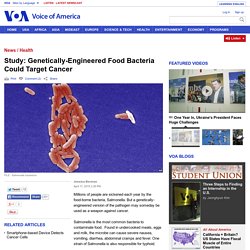
But a genetically-engineered version of the pathogen may someday be used as a weapon against cancer. Are You Handling Raw Chicken The Wrong Way? Americans eat 8 billion chickens a year.

That’s right — billion with a “B.” But about one in four pieces of raw chicken carry salmonella, and salmonella from poultry sickens 200,000 Americans a year, according to government data. Handling chicken properly and cooking it well is supposed to get rid of the salmonella. However, a recent study found that while preparing to cook their chicken, people often make mistakes that can cause them to unknowingly contaminate their kitchen. The 56 households that participated in the study seemed to know how to handle raw poultry — based on their responses to questionnaire from the study’s authors. Eyob Mazengia was among the team of researchers who worked on the study, which was published in Food Protection Trends Journal in January. “People are not aware of how they are cross-contaminating their kitchen surfaces,” Mazengia told FRONTLINE. “There’s a gap in the system,” he said. Antibiotics may help Salmonella spread in infected animals, scientists learn. In Monack’s lab, more than 1 in 5 salmonella-infected mice are superspreaders.

“The mice we use are inbred,” she noted. “So this difference in response to salmonella infection can’t be just a simple matter of genetic mutations.” We need to think about the possibility that we’re not only selecting for antibiotic-resistant microbes, but also impairing the health of our livestock. The Stanford investigators had previously published work showing that giving non-superspreader mice an oral antibiotic, which kills some of the friendly microbes that ordinarily inhabit mammals’ intestines and provide protection against invading pathogens, led to a rapid increase in salmonella shed in their feces.
In the new study, the scientists gave streptomycin, an antibiotic, to salmonella-infected mice. Giving the mice another antibiotic, neomycin, produced the same outcomes. Symptom-free superspreaders. Study identifies virulence factors for Salmonella. The ability of molecular assays to identify pathogenic strains of Salmonella, with an emphasis on S.
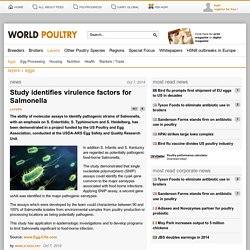
Enteritidis, S. Typhimurium and S. Heidelberg, has been demonstrated in a project funded by the US Poultry and Egg Association, conducted at the USDA-ARS Egg Safety and Quality Research Unit. Five Salmonella Outbreaks Food Inspectors Didn’t See Coming. Federal inspectors are inside every meat and poultry processing plant in this country. The problem is, their efforts sometimes fail to identify salmonella — a potentially deadly pathogen that sickens more than a million Americans each year, about 200,000 from contaminated poultry. The five cases detailed below offer a window into why.
Each example represents a multi-state salmonella outbreak linked to chicken or turkey. In each case, government officials were able to trace contaminated poultry back to specific processing plants. But in all five cases, routine testing in the six months before people began falling sick didn’t detect signs of salmonella problems that could lead to outbreaks. How is that possible? One explanation can be found in the way inspectors with the U.S. Why The U.S. Chills Its Eggs And Most Of The World Doesn't. To refrigerate or not to refrigerate?
It boils down to bacteria, aesthetics and how much energy you're willing to use. Robert S. Donovan; Flickr / Alex Barth; Flickr hide caption toggle caption Robert S. Donovan; Flickr / Alex Barth; Flickr. Rising Salmonella infections tied to backyard poultry flocks. Salmonella.